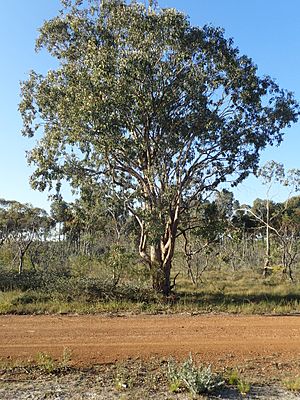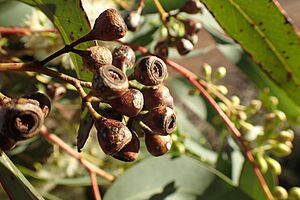Ribbon-barked gum facts for kids
Quick facts for kids Ribbon-barked gum |
|
|---|---|
 |
|
| Eucalyptus sheathiana in Helms Arboretum, near Esperance | |
| Scientific classification | |
| Genus: |
Eucalyptus
|
| Species: |
sheathiana
|
The Ribbon-barked gum (scientific name: Eucalyptus sheathiana) is a special kind of tree. Sometimes it grows as a full tree, and sometimes it's a smaller, bushy plant called a mallee. This plant is endemic to Western Australia, which means it only grows naturally there.
You can easily spot the Ribbon-barked gum because its smooth bark peels off in long, ribbon-like strips. It has long, narrow adult leaves, and its flower buds grow in groups of seven. When it blooms, you'll see creamy white flowers. After the flowers, it grows interesting cone-shaped or cup-shaped fruits.
What Does It Look Like?
The Ribbon-barked gum can be a tree or a mallee. It usually grows to be about 3 to 15 meters tall. It also has a special woody swelling at its base called a lignotuber. This helps the plant regrow after fires.
Its bark is smooth and greyish, and it peels off in long ribbons. Young plants and new shoots have greyish-green leaves that are shaped like an egg or a spear. These leaves are about 7.5 to 12.5 centimeters long and 2.5 to 4 centimeters wide.
Adult leaves are shaped like a spear, about 7.5 to 13.5 centimeters long and 0.8 to 1.8 centimeters wide. They narrow down to a stalk called a petiole, which is about 1 to 2.8 centimeters long.
The flower buds grow in the leaf axils (where the leaf meets the stem). They are on a stalk called a peduncle, which is about 0.5 to 2 centimeters long. Each individual bud has its own small stalk, about 0.3 to 0.7 centimeters long.
Mature buds are oval or pear-shaped, about 0.6 to 1.2 centimeters long and 0.4 to 0.7 centimeters wide. They have a cone-shaped cap called an operculum.
The Ribbon-barked gum flowers between January and April. Its flowers are a lovely creamy white color. After flowering, it produces woody fruits. These fruits are shaped like a cone or a cup, about 0.5 to 1 centimeter long and 0.5 to 0.8 centimeters wide.
How It Got Its Name
The scientific name Eucalyptus sheathiana was first officially described in 1916. It was named by a botanist named Joseph Maiden. He used plant material collected by Jeremiah Sheath. Sheath collected the seeds from the "Eastern Gold Fields near the South Australian border."
The second part of its scientific name, sheathiana, was chosen to honor Jeremiah Sheath, who collected the original plant samples.
Where Does It Grow?
This special eucalypt tree is found in the southern part of the Wheatbelt region in Western Australia. You can find it between towns like Wongan Hills, Nyabing, and Lake King. It also grows in nearby areas of the Goldfields-Esperance region.
The Ribbon-barked gum likes to grow in shrubland areas. It prefers sandy soils that contain a type of rock called lateritic soil.
Is It Safe?
The Western Australian Government's Department of Parks and Wildlife has looked at the Ribbon-barked gum. They have classified it as "not threatened." This means that currently, there are enough of these trees, and they are not in danger of disappearing.



